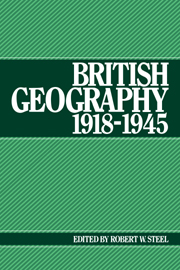Book contents
- Frontmatter
- Contents
- Preface
- 1 The beginning and the end
- 2 Geography during the inter-war years
- 3 Geography in the University of Wales, 1918–1948
- 4 Geography at Birkbeck College, University of London, with particular reference to J. F. Unstead and E. G. R. Taylor
- 5 The Oxford School of Geography
- 6 Geography in the Joint School (London School of Economics and King's College)
- 7 Geography in a University College (Nottingham)
- 8 Geographers and their involvement in planning
- 9 On the writing of historical geography, 1918–1945
- 10 Physical geography in the universities, 1918–1945
- 11 Geographers and geomorphology in Britain between the wars
- 12 British geography, 1918–1945: a personal perspective
- Index
8 - Geographers and their involvement in planning
Published online by Cambridge University Press: 07 October 2009
- Frontmatter
- Contents
- Preface
- 1 The beginning and the end
- 2 Geography during the inter-war years
- 3 Geography in the University of Wales, 1918–1948
- 4 Geography at Birkbeck College, University of London, with particular reference to J. F. Unstead and E. G. R. Taylor
- 5 The Oxford School of Geography
- 6 Geography in the Joint School (London School of Economics and King's College)
- 7 Geography in a University College (Nottingham)
- 8 Geographers and their involvement in planning
- 9 On the writing of historical geography, 1918–1945
- 10 Physical geography in the universities, 1918–1945
- 11 Geographers and geomorphology in Britain between the wars
- 12 British geography, 1918–1945: a personal perspective
- Index
Summary
In 1946 in his inaugural address at the London School of Economics entitled ‘Applied geography’, L. Dudley Stamp remarked on ‘the almost parallel careers of geography and town planning’. Throughout more than the first half of the period with which this volume is concerned this was literally true, for parallel lines do not meet. Both subjects were slowly developing but by the early thirties neither had reached the stage of being held in great respect by other disciplines, and planners certainly had produced very few publications of general interest. The numbers of professionals in both subjects were few indeed. The Town Planning Institute had been formed in 1913 by architects, engineers and surveyors and its members worked principally in the departments of local government concerned with such matters as roads and drains. It had only a few hundred members by the time the Institute of British Geographers was formed twenty years later with, initially, less than eighty members.
Those latter pioneers were almost exclusively engaged, and very heavily engaged, in university teaching, without the help of technicians. A high proportion of their students expected to become teachers of geography, an increasingly popular subject by then well established in the curriculum of secondary schools. I was such a student.
- Type
- Chapter
- Information
- British Geography 1918–1945 , pp. 100 - 116Publisher: Cambridge University PressPrint publication year: 1987
- 1
- Cited by

